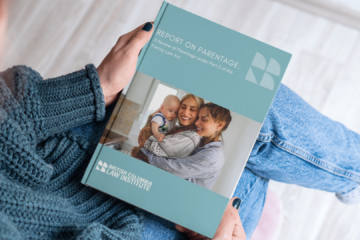UK court allows posthumous use of embryo despite lack of written consent
June 30, 2022
BY Kevin Zakreski
In a recent decision, the family division of the High Court of England and Wales allowed a husband to use an embryo created by in vitro fertilization with his wife for birth by surrogacy, even though the wife (who died after creation of the embryo by IVF) didn’t provide written consent for this use. The decision has attracted media attention in the United Kingdom as “a landmark legal case,” which “could be the UK’s first case of posthumous surrogacy.”
Facts of the case
Jennings v Human Fertilisation and Embryology Authority, [2022] EWHC 1619 (Fam) concerned a husband’s application to the court for “a declaration that it is lawful for him to use an embryo created using his sperm and the eggs of his late wife . . . in treatment with a surrogate.” The court summarized the facts of the case as follows:
[7] Mr Jennings and Ms Choya had been in a loving and committed relationship since 2007. They married in 2009 and wanted to have a family of their own. They experienced difficulties in conceiving naturally, sought fertility advice and underwent three cycles of IVF treatment at the Hammersmith Hospital in 2013 and 2014 which were not successful. Ms Choya conceived naturally in 2015 and 2016 but both pregnancies ended in miscarriage due to ectopic pregnancy. Mr Jennings and Ms Choya underwent further cycles of IVF treatment, re-mortgaging their home to fund private treatment at CRGH [Centre for Reproductive and Genetic Health].
[8] Their final cycle of treatment was in late 2018. At that point they only had one embryo, so prior to the embryo transfer underwent two further batching cycles to acquire more embryos to enable them to have more than one child. Once they had two embryos in storage they proceeded with the single embryo transfer in November 2018. A positive pregnancy with twin girls was confirmed in November 2018. Ms Choya developed complications in her pregnancy at 18 weeks, which resulted in a uterine rupture, and she died on 25 February 2019. It is the remaining embryo that is the subject of this application.
Even though, “[a]s part of their fertility treatment Mr Jennings and Ms Choya completed a number of forms” (at para. 9), Ms. Choya never signed the prescribed form required for consent to use of an embryo for surrogacy. This was because the prescribed “form used at the material time did not provide any opportunity for a woman to consent to a partner-created embryo being used for her partner’s treatment if she dies” (at para. 13) and she was never offered the different prescribed form in use for this purpose (at para. 21). In contrast, her husband signed a prescribed form (intended for use only by men) that allowed him to check a “box to record Mr Jennings’ consent to their partner-created embryos being used in Ms Choya’s treatment in the event of Mr Jennings’ death” (at para. 15).
Arguments of the parties
So while Mr. Jennings conceded that “there is no written consent by Ms Choya” for use of the embryo in surrogacy, he argued before the court that the couple “were not given sufficient information or opportunity to give that written consent and, if they had been, the court can infer from all the evidence Ms Choya would have given it” (at para. 2).
The United Kingdom’s fertility-treatments regulator—the Human Fertilisation and Embryology Authority—was served with the application as an interested party. It “oppose[d] the declaration sought on the basis that there was not a valid written consent by Ms Choya at the relevant time to use the remaining embryo in the way sought by the declaration in the event of her death. The statutory scheme requires such consent to be in writing and the HFEA submit Ms Choya had sufficient information and opportunity to give that written consent” (at para. 5).
The court’s decision
The court began by stating “the issue between the parties,” which “relates to the requirement that consent be recorded in writing and signed by the person giving it” (at para. 31). In brief, the court’s approach to resolving this issue involved “acknowledg[ing that] the issue of consent is the cornerstone of the statutory scheme and that the statutory scheme requires such consent to be in writing,” but “that cannot, in my judgment, be considered in a vacuum. It is necessary to consider the circumstances in which such consent is considered, the information that was available and what opportunity was given for that consent to be given” (at para. 82).
The court emphasized two considerations from these surrounding circumstances:
- the regulator’s prescribed forms treated men and women differently and the form used for women wasn’t clear on this issue (“[i]n my judgment, whilst it is right the WT [= women’s consent to treatment and storage (IVF and ICSI)] form does give some prompts about what a woman should do about providing consent to posthumous use by her partner of a partner-created embryo, they are far from clear”—at para 88); and
- there was ample evidence made available to the court that Ms. Choya would have provided written consent to posthumous use of the embryo for birth by a surrogate if she had been given that option. (“Turning to the issue of Ms Choya’s consent I am satisfied that, in the circumstances of this case, the court can infer from all the available evidence that Ms Choya would have consented to Mr Jennings being able to use their partner-created embryo in treatment with a surrogate in the event of her death. This is being considered in the context where, in my judgment, she had not been given relevant information and/or a sufficient opportunity to discuss it with the clinic”—at para. 92.)
In deciding to grant Mr. Jennings the declaration he requested, the court concluded (at para. 101):
Consent is a critical issue within the statutory scheme but what is important is to consider the role and purpose of consent in the statutory scheme, which is to ensure that gametes and embryos are used in accordance with the relevant person’s wishes. The reference to written con-sent is an evidential rule with the obvious benefits of certainty but it is not inviolable where the circumstances may require the Court to intervene.
Further, the court added the following comments to characterize the significance of its decision (at para. 104):
This is a case very much on its own particular facts. I agree with Ms Richards [Mr. Jennings’s lawyer] it will not open any floodgates. Parliament intended to enable a deceased person whose gametes had been used to create an embryo with their partner for that partner to be the named person to use that embryo after their death, provided it was the deceased’s wish recorded in writing. In my judgment the court can and should read down the requirement in Schedule 3 to dispense with the requirement for written and signed consent in this limited situation where a person has been denied a fair and reasonable opportunity in their lifetime to provide consent for the posthumous use of their embryos and there is evidence that the court concludes, directly and/or by inference, that if that opportunity had been given, that consent by that person would have been provided in writing. This does not, in these very limited circumstances, go against the grain of the legislation and ensures Mr Jennings’ Convention rights are respected.
A contrast with British Columbia
The Jennings decision in general and these comments in particular stand in contrast to the leading British Columbia case on written consent to the posthumous use of genetic material for fertility treatments, L.T. v D.T. Estate, 2020 BCCA 328. In this case, the court of appeal emphasized the importance of upholding a legislative requirement for written consent:
[23] The effect of the AHRA and the Regulation read together is unequivocal and clear. In the exercise of its power over the criminal law, Parliament has declared definitively what will count as consent for permissibly removing reproductive material posthumously from a donor. No other forms of “consent” can have any application in rendering the posthumous removal of reproductive material lawful. Implied, hypothetical, imputed, or substituted consent are simply not consent for the purpose of avoiding the prohibition set out in s. 8 and the Regulation. Parliament has provided for legal certainty in what is, without doubt, a morally challenging and humanly complex area.
[24] Respectfully, this is not, as was suggested in argument, an interpretation of the statute lacking in nuance. It is not a narrow reading. It is a recognition that Parliament has made a policy choice. Parliament has defined the only circumstances in which it is lawful to remove and use reproductive material from a donor. That choice reflects the value Parliament has placed on a donor’s individual autonomy and an individual’s control over his or her body. It has made that choice in the face of numerous deep moral and ethical dilemmas posed by new reproductive technologies. [emphasis in original]
How did these courts arrive at such different conclusions? This short summary can’t definitively answer that question, but it can point to two sets of contrasts that could form the basis of a fuller, more detailed answer.
- Factual contrasts. In L.T. v D.T. Estate, the BC Court of Appeal noted that “[n]either Mr. T nor Ms. T considered what would happen if one or other of them died. They did not turn their minds to the possible posthumous use of their reproductive material. The judge concluded that, like most other young couples, they had not put their minds to that circumstance.” In contrast, Mr. Jennings and Ms. Choya were a middle-aged couple, who had undergone many years of fertility treatment, during which they had created a significant evidentiary record in their actions, their statements to close friends and family, and their written documents, all of which indicated a clear desire “that Ms Choya would have wanted Mr Jennings to be able to use their partner-created embryo in treatment with a surrogate in the event of her death” (Jennings at para 31; see also paras 92–94).
- Legal contrasts. Legally, the two cases turn on the courts’ interpretation of the complex legal frameworks governing assisted reproduction in Canada and the United Kingdom. These legal frameworks differ, of course, at the level of detail. For example, the UK legislation contains a provision (not found in the Canadian act or regulations) stating that a person who gives consent “must be provided with such relevant information as is proper”—which the court noted wasn’t fulfilled in Ms. Choya’s case (at paras. 90, 101). But a more striking contrast is the role that constitutional law plays in the two judgments. For the BC Court of Appeal, the branch of constitutional law that was engaged was the division of powers between the federal and provincial governments. This consideration guided the court in interpreting the legal framework (“Before I set out the legislative scheme, I repeat that the only issue before us is one of statutory interpretation. Parliament has enacted the provisions we must interpret further to its constitutional power over the criminal law. The provisions in issue are part of the criminal law and the prohibition of the removal of a donor’s reproductive material without consent is criminal in nature. This fact influences statutory interpretation because in enacting a criminal prohibition one would expect Parliament to attempt to achieve clarity and certainty.”) In contrast, the English High Court drew on the European Convention on Human Rights (the equivalent of the Canadian Charter of Rights and Freedoms) in interpreting the UK legal framework (“Mr Jennings’ Article 8 right to respect for the decision to become a parent in the genetic sense has been interfered with. The interference with that right is not proportionate on the facts of this case. Whilst the requirement for writing undoubtedly pursues a legitimate aim, in the circumstances of this case, where, on the findings the court has made, there was a lack of opportunity to Ms Choya to provide that consent in writing, in circumstances where I conclude she would have given that consent, the interference with Mr Jennings’ Article 8 right would be significant, final and lifelong. There are no weighty countervailing factors to justify the significant interference, there is no conflict of individuals’ rights and permitting the application would not undermine a fundamental objective of the statutory scheme, namely the requirement for consent”—at para. 102).











































